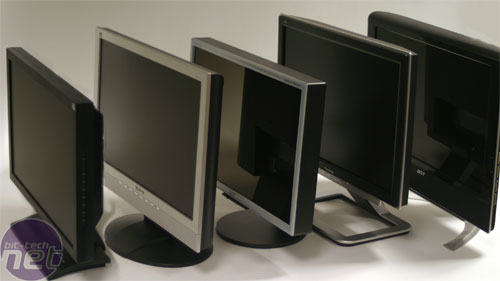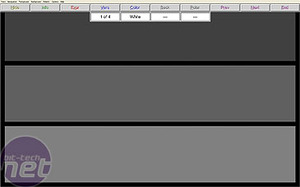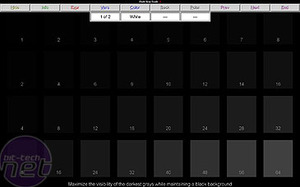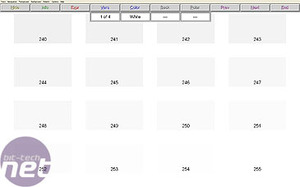20" widescreen monitor group test
March 30, 2006 | 21:36
Companies: #acer #benq #nec #test #viewsonic

Everyone likes flat panels, right? They're more convenient than CRTs, they look better, and they're easier to stare at for long hours of desktop work. OK, so they're not quite as good for gaming, but with technology improving, they're swiftly getting there.
And, of course, they come in widescreen. 20" and 24" panels are swiftly becoming must-have items for high-end enthusiasts and gamers, with decent response times and resolutions leading to some kick-ass products.
We know that many of you are in the market for monitor upgrades right now, and 20" panels hit a very nice sweet spot of price and resolution. With that in mind, we grabbed five of the top panels right now to find out which one is worth your cash.

The price range we're looking at is the £300-£400 range. Above that, you start to get into the territory of 24" screens from companies like Dell and Samsung. Below that, you're going into a range occupied mostly by 19" displays at 1280x1024.
The LCDs we have here today all share a certain number of features. For one, they all have a screen resolution of 1680x1050, which is a widescreen resolution (obviously). They all have response times of 8ms or below, which means you're not going to see any ghosting on fast moving images. They all have single VGA and single DVI inputs.
None of the displays have HDMI connectors and none of them support HDCP. This means you're not going to get a digital connection to your HD-DVD movies, but there is currently very little on the market that will.
DisplayMate: We started our tests with a run of the LCD tests in DisplayMate.

 There are four key tests that we examined to check out the raw image quality of the display. On the left here is a Grey Dithering test. The three shades of grey are made out of dithered shades - shades of grey mixed with other, slightly different colours. A bad display will get confused about what the dithering is doing, and will put a green or pink tint on the greys. On the right is a colour shading test. A good monitor will have the colours fade to black at the exact same point on the left. A bad monitor will have at least one of the colours fading to black at a different point, creating a shadow 'curve'.
There are four key tests that we examined to check out the raw image quality of the display. On the left here is a Grey Dithering test. The three shades of grey are made out of dithered shades - shades of grey mixed with other, slightly different colours. A bad display will get confused about what the dithering is doing, and will put a green or pink tint on the greys. On the right is a colour shading test. A good monitor will have the colours fade to black at the exact same point on the left. A bad monitor will have at least one of the colours fading to black at a different point, creating a shadow 'curve'.

 These two tests are designed to show compression at the top and bottom end of the colour spectrum. On a good monitor, every different shade of grey/black and beige/white will be distinguishable. On a poor monitor, the darkest/lightest two or three shades will all appear exactly the same.
These two tests are designed to show compression at the top and bottom end of the colour spectrum. On a good monitor, every different shade of grey/black and beige/white will be distinguishable. On a poor monitor, the darkest/lightest two or three shades will all appear exactly the same.
Subjective testing: We then emarked on a series of tests to judge, subjectively, what we thought the quality was. Starting with Windows work, we employed the same kick-ass wallpaper artwork from our friends at Little-Gamers. In fact, keep reading for a chance to win some great Little Gamers freebies.
Moving to gaming, played Quake 4 on each monitor to look at how it managed the blacks and the dark areas of the game, but also to see how vivid and clear the image was.
We also tested the Superbit DVD of Crouching Tiger, Hidden Dragon. We looked at Chapter 7 and Chapter 25, which both have lots of detail that can get lost on bad monitors, either through an oversaturation of colour or a lack of contrast.
The high definition trailer for the new Miami Vice film has an interesting mix of content - there are dark scenes with a lot of simulated grain and bright scenes with very vivid colours and sharp text. We watched this to see how the monitor coped with the mix.
And, of course, they come in widescreen. 20" and 24" panels are swiftly becoming must-have items for high-end enthusiasts and gamers, with decent response times and resolutions leading to some kick-ass products.
We know that many of you are in the market for monitor upgrades right now, and 20" panels hit a very nice sweet spot of price and resolution. With that in mind, we grabbed five of the top panels right now to find out which one is worth your cash.

So why are we here?
Let's define the point of this test. We're going to make the assumption that you've got a half-decent graphics card, and you're looking for a new flat panel to connect to it. You want to watch movies on DVD and in hi-def (either as Apple trailers or via BitTorrent) and you want to play the latest games.The price range we're looking at is the £300-£400 range. Above that, you start to get into the territory of 24" screens from companies like Dell and Samsung. Below that, you're going into a range occupied mostly by 19" displays at 1280x1024.
The LCDs we have here today all share a certain number of features. For one, they all have a screen resolution of 1680x1050, which is a widescreen resolution (obviously). They all have response times of 8ms or below, which means you're not going to see any ghosting on fast moving images. They all have single VGA and single DVI inputs.
None of the displays have HDMI connectors and none of them support HDCP. This means you're not going to get a digital connection to your HD-DVD movies, but there is currently very little on the market that will.
How we tested
We wanted to test the monitors in a way that would be realistic and would give some meaningful results.DisplayMate: We started our tests with a run of the LCD tests in DisplayMate.




Subjective testing: We then emarked on a series of tests to judge, subjectively, what we thought the quality was. Starting with Windows work, we employed the same kick-ass wallpaper artwork from our friends at Little-Gamers. In fact, keep reading for a chance to win some great Little Gamers freebies.
Moving to gaming, played Quake 4 on each monitor to look at how it managed the blacks and the dark areas of the game, but also to see how vivid and clear the image was.
We also tested the Superbit DVD of Crouching Tiger, Hidden Dragon. We looked at Chapter 7 and Chapter 25, which both have lots of detail that can get lost on bad monitors, either through an oversaturation of colour or a lack of contrast.
The high definition trailer for the new Miami Vice film has an interesting mix of content - there are dark scenes with a lot of simulated grain and bright scenes with very vivid colours and sharp text. We watched this to see how the monitor coped with the mix.

MSI MPG Velox 100R Chassis Review
October 14 2021 | 15:04








Want to comment? Please log in.